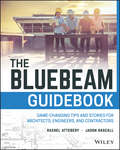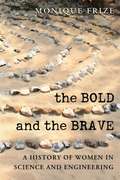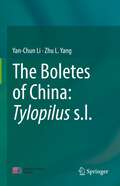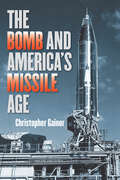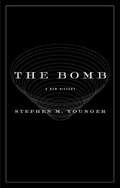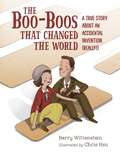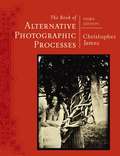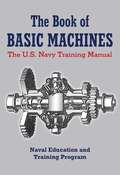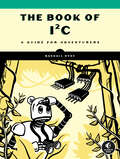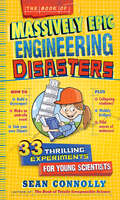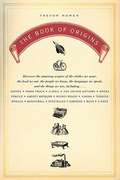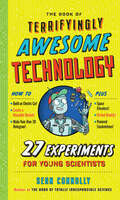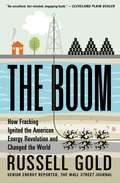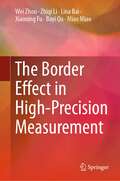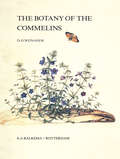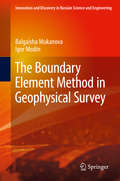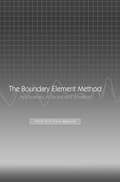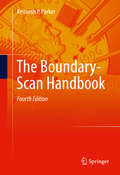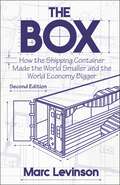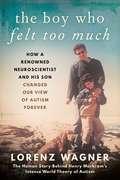- Table View
- List View
The Bluebeam Guidebook: Game-changing Tips and Stories for Architects, Engineers, and Contractors
by Rachel Attebery Jason HascallExpert tips for the last piece in the paperless puzzle The Bluebeam Guidebook offers comprehensive coverage of the industry’s leading PDF tool to help AEC professionals adopt a more efficient digital workflow. With desktop, mobile, and server-based products, Bluebeam makes collaboration and document coordination seamless, and provides a perfect complement to BIM software. This book shows you how to push the boundaries and discover the software’s true capabilities. Written expressly for working AEC professionals, this book offers tips, tricks, and ideas that cater to industry-specific needs. Expert instruction and step-by-step guidance helps you get started quickly, and case studies feature users from firms such as Kiewit, Populus, Sundt Construction, and more to show you how Bluebeam is quickly becoming a critical component of design and construction. Master the industry’s leading PDF software and alternative to Adobe Acrobat Create, edit, and markup documents in a way that suits the architecture and engineering workflow Learn how major AEC firms have transitioned seamlessly to digital workflows Integrate Bluebeam into estimating, quality control, field applications, and more The days of file boxes and paper reams are quickly coming to a close. The transition to paperless has been a boon for the AEC industry, in which collaboration and document sharing is central to getting the job done. BIM has revolutionized the design process, and Bluebeam offers that same level of functional innovation for the document side of every project. For AEC professionals seeking a better way to get things done, The Bluebeam Guidebook is your ultimate guide to everything Bluebeam can do for you.
The Blurred Blogger (Tom Swift Inventors' Academy #7)
by Victor AppletonTom and his friends track down a mysterious blogger who pushes pranks too far in this seventh novel in Tom Swift Inventors&’ Academy—perfect for fans of The Hardy Boys or Alex Rider series.A series of videos called &“The Not-so-Swift Academy&” are the talk of Tom Swift&’s tech-focused school. A mysterious host whose face is blurred shows hidden camera footage of different students being pranked—from a rubber tarantula leaping out of one of the terrariums to water flash freezing. Tom and his classmates are on edge, wondering which unlucky student will be the star of the next episode. They&’re on the lookout for hidden cameras and searching for signs of the next prank around every corner and behind every locker door. Tired of the tension, Sam decides to take matters in her own hands. She&’s going to bust the blogger by studying the videos for clues. But as Sam pieces the clues together, she unveils the biggest prank of all—someone&’s trying to frame her for the videos! Can Tom and his friends unmask the blurred blogger and clear Sam&’s name before they become the targets of the prankster&’s increasingly nefarious stunts?
The Boat Alphabet Book (Jerry Pallotta's Alphabet Books)
by Jerry PallottaAhoy, mateys! Get on board! Boats and the need for them have been around for thousands of years. Reed boats might have been the first boat ever to be built. The Vikings built wooden ships that were strong and ornate. And now boats like an Aircraft Carrier house 6,000 people and can carry over 100 planes. In Jerry Pallotta's newest book we get to see an entire alphabet of floating wonders. David Biedrzycki has provided dramatic settings for a variety of boats and captures the mood of each body of water. In one he paints a calm lake where a red canoe glides across the water and in another the stormy swells of an angry ocean tossing a three-masted Xebec. The facts about each boat are sprinkled with traditional Pallotta humor.
The Bold and the Brave: A History of Women in Science and Engineering
by Monique FrizeThe Bold and the Brave investigates how women have striven throughout history to gain access to education and careers in science and engineering. Author Monique Frize, herself an engineer for over 40 years, introduces the reader to key concepts and debates that contextualize the obstacles women have faced and continue to face in the fields of science and engineering. She focuses on the history of women’s education in mathematics and science through the ages, from antiquity to the Enlightenment. While opportunities for women were often purposely limited, she reveals how many women found ways to explore science outside of formal education. The book examines the lives and work of three women –Sophie Germain, Mileva Einstein, and Rosalind Franklin – that provide excellent examples of how women’s contributions to science have been dismissed, ignored or stolen outright. She concludes with an in-depth look at women’s participation in science and engineering throughout the twentieth century and the current status of women in science and engineering, which has experienced a decline in recent years. To encourage more young women to pursue careers in science and engineering she advocates re-gendering the fields by integrating feminine and masculine approaches that would ultimately improve scientific and engineering endeavours.
The Boletes of China: Tylopilus s.l.
by Yan-Chun Li Zhu L. YangThis book introduces the Chinese boletes, including the history, ecological and economic values, as well as the geographical distribution patterns with a highlight on the Tylopilus species. Species in Tylopilus s.l. are not only of important ecological values but also of scientific interests. They are very diverse in morphology, complex in structure and wide in ecological niches. China is one of the diverse hotspots of boletes, and many boletes were traditionally treated as members of Tylopilus based on hymenophore or spore-print colour. The studies revealed that the traditionally defined Tylopilus is polyphyletic. This book aims to elucidate the phylogenetic relationships among the genera treated in Tylopilus s.l. previously; to delimit and recognize the taxa, and finally to reveal the diversity of the genera and species of Tylopilus s.l. in China. The book is intended to be a reference for biologists who conduct investigations of biological resources and biodiversity; university and college teachers and students carrying out studies in related fields; mycologists and amateur mycologists, or people who interested in mushrooms taxonomy and systematics; and workers in the development of non-timber forest products.
The Bomb and America's Missile Age (The Johns Hopkins University Studies in Historical and Political Science #133)
by Christopher GainorHow nuclear weapons helped drive the United States into the missile age.The intercontinental ballistic missile (ICBM), designed to quickly deliver thermonuclear weapons to distant targets, was the central weapons system of the Cold War. ICBMs also carried the first astronauts and cosmonauts into orbit. More than a generation later, we are still living with the political, technological, and scientific effects of the space race, while nuclear-armed ICBMs remain on alert and in the headlines around the world.In The Bomb and America’s Missile Age, Christopher Gainor explores the US Air Force’s (USAF) decision, in March 1954, to build the Atlas, America’s first ICBM. Beginning with the story of the guided missiles that were created before and during World War II, Gainor describes how the early Soviet and American rocket programs evolved over the course of the following decade. He argues that the USAF was wrongly criticized for unduly delaying the start of its ICBM program, endangering national security, and causing America embarrassment when a Soviet ICBM successfully put Sputnik into orbit ahead of any American satellite. Shedding fresh light on the roots of America’s space program and the development of US strategic forces, The Bomb and America’s Missile Age uses evidence uncovered in the past few decades to set the creation of the Atlas ICBM in its true context—not only in the America of the postwar years but also in comparison with the real story of the Soviet missiles that propelled the space race and the Cold War. Aimed at readers interested in the history of the Cold War and of space exploration, the book makes a major contribution to the history of rocket development and the nuclear age.
The Bomb in My Garden: The Secrets of Saddam's Nuclear Mastermind
by Mahdi Obeidi Kurt PitzerObeidi, the former director-general of Iraq's Ministry of Industry and Military Industrialization under Saddam Hussein, was involved in Iraq's quest for a nuclear bomb beginning in the late 1970s. In this memoir, he tells his story of his work in the program, describing how the efforts came to a halt after the first Gulf War, and how he watched as the U. S. used allegations he knew were false to justify the invasion of his country. In many parts, the story is as much personal as professional as he worries about the fate of his family in difficult times.
The Bomb: A New History
by Steven M. YoungerA former Los Alamos weapons designer shares “an indispensable guide to the science and strategy of nuclear weapons” (Booklist).From his years at Los Alamos and the Nevada Test Site to his meetings with nuclear arms experts in Moscow, former weapons designer Stephen M. Younger has witnessed firsthand the making of nuclear policy. With a deep understanding of both the technology and the politics behind nuclear weapons, he guides us from the Manhattan Project to the Cold War and into the present day, illuminating how nuclear weapons fit into our globalized, war-plagued world. With startling clarity, Younger reveals how weapons work, the myths and realities of what happens after a nuclear explosion, and how our nuclear policy evolved to what it is today. In an era when rogue nations like North Korean and Iran strive to create their own precarious weapons programs, Younger provides much-needed background and insight for students, policy makers, and readers who wish to better understand the important issues involving nuclear weapons and national security.“Younger has provided an insightful guide, especially for the general reader, into today’s array of nuclear powers and their capabilities.” —James Schlesinger, former Secretary of Defense and Secretary of Energy
The Boo-Boos That Changed the World: A True Story About an Accidental Invention (Really!)
by Barry WittensteinDid you know Band-Aids were invented by accident?! And that they weren't mass-produced until the Boy Scouts gave their seal of approval?1920s cotton buyer Earle Dickson worked for Johnson & Johnson and had a klutzy wife who often cut herself. The son of a doctor, Earle set out to create an easier way for her to bandage her injuries. Band-Aids were born, but Earle's bosses at the pharmaceutical giant weren't convinced, and it wasn't until the Boy Scouts of America tested Earle's prototype that this ubiquitous household staple was made available to the public. Soon Band-Aids were selling like hotcakes, and the rest is boo-boo history."Appealingly designed and illustrated, an engaging, fun story" — Kirkus Reviews STARRED REVIEW
The Book of Alternative Photographic Processes (3rd Edition)
by Christopher JamesA complete and comprehensive technical and aesthetic resource, exploring and delving into every aspect of alternative photographic process photography. This 3rd Edition is the definitive text for students and professionals studying alternative photographic processes and the art of hand-made photographic image making. The text brings the medium up to date with new and historic processes that are integrated with the latest contemporary innovations, adaptations, techniques, and art work.
The Book of Basic Machines: The U.S. Navy Training Manual
by U. S. NavyHave you ever wondered why levers and pulleys make it easy to lift heavy objects? Or thought about what it is that makes a combustion engine work?The Book of Basic Machines will give you the information you need to understand key concepts, techniques, components, and much more. Designed and prepared by the Naval Education and Training Program Development Center for naval training, and taught widely in technical school across the country, the manual covers the theory and application of many of the most important mechanical ideas. Concepts build effortlessly from one chapter to the next. Clear explanations, illuminating examples, and over 200 skillfully rendered diagrams, cross-sections, and illustrations make it remarkably easy for readers of any level to understand the fascinating inner-workings of basic machines. The Book of Basic Machines is an invaluable resource for mechanical engineering students looking to learn the basics, working engineers wanting to brush up on some theory, or hobbyists who simply want to know how things work. Simply put, this book is required reading for anyone interested in machines. From the basics of simple levers to the principles of the internal combustion engine, The Book of Basic Machines covers every aspect of basic machinery.
The Book of I²C: A Guide for Adventurers
by Randall HydeAn extensive practical guide to connecting real-world devices to microcontrollers with the popular I2C bus.If you work with embedded systems, you&’re bound to encounter the ubiquitous Inter-Integrated Circuit bus (IIC or I2C) – a serial protocol for connecting integrated circuits in a computer system. In The Book of I2C, the first comprehensive guide to this bus, bestselling author Randall Hyde draws on 40 years of industry experience to get you started designing and programming I2C systems. Aided by over 100 detailed figures and annotated source-code listings, you&’ll learn the I2C implementations of systems like Arduino, Teensy, and Raspberry Pi, as well as variants of the I2C and common I2C peripheral ICs complete with programming examples. For hardware hackers, electronics hobbyists, and software engineers of every skill level, the extensive coverage in this book will make it a go-to reference when it comes to connecting real-world devices to I2C microcontrollers.
The Book of Massively Epic Engineering Disasters: 33 Thrilling Experiments Based on History's Greatest Blunders (Irresponsible Science)
by Sean ConnollyIt’s hands-on science with a capital “E”—for engineering. Beginning with the toppling of the Colossus of Rhodes, one of the seven wonders of the ancient world, to the destructive, laserlike sunbeams bouncing off London’s infamous “Fryscraper” in 2013, here is an illustrated tour of the greatest engineering disasters in history, from the bestselling author of The Book of Totally Irresponsible Science. Each engineering disaster includes a simple, exciting experiment or two using everyday household items to explain the underlying science and put learning into action. Understand the Titanic’s demise by sinking an ice-cube-tray ocean liner in the bathtub. Stomp on a tube of toothpaste to demonstrate what happens to non-Newtonian fluids under pressure—and how a ruptured tank sent a tsunami of molasses through the streets of Boston in 1919. From why the Leaning Tower of Pisa leans to the fatal design flaw in the Sherman tank, here’s a book of science at its most riveting.
The Book of Origins: Discover the Amazing Origins of the Clothes We Wear, the Food We Eat, the People We Know, the Languages We Speak, and the Things We Use
by Trevor HomerEverything—from the mundane (the pencil) to the catastrophic (the atom bomb)—has an origin, but often it&’s not what we expect. A few things you may not have known: • Gandhi was married at age thirteen! • Chinese fortune cookies are an American invention and were not eaten in China until the 1990s when they were advertised as &“Genuine American Fortune Cookies.&” • Bayer lost the trademark for aspirin (which they had held since 1897) as part of the reparations Germany was forced to pay after World War I. • The original idea for the electric chair came from an American dentist. For aspiring mindblowers and wanna-be know-it-alls, The Book of Origins is a treasure trove of trivia and fascinating facts guaranteed to entertain and enlighten.
The Book of Terrifyingly Awesome Technology: 27 Experiments for Young Scientists (Irresponsible Science)
by Sean ConnollySean Connolly’s bestselling “genius at work” series gets its “T!” STEM, standing for Science, Technology, Engineering, and Mathematics, refers to the core non-humanities subjects that are so critical to contemporary education. And now, after covering everything but the technology, this master of fun, messy, possibly risky and compelling interactive science experiments explores twenty-seven key areas in current and near-future tech. Author of The Book of Totally Irresponsible Science, The Book of Massively Epic Engineering Disasters, and, most recently, The Book of Ingeniously Daring Chemistry Sean Connolly delves into the fascinating and potentially scary world of driverless cars, artificial intelligence, robots and androids, smart clothing, the “internet of things,” test-tube meat, the space elevator, and more. Through cool illustrations, quick definitions, illustrated panels, and Connolly's clear and always-lively writing, readers learn what each breakthrough means; how it has or will improve our lives; what other technologies are related to it; and what the terrifyingly awesome potential risks are. (3D printing? What happens when someone bad “prints” a weapon?) And to make the learning hands-on, each chapter includes an experiment to help understand the underlying principles of these incredibly complicated developments: Use milk jugs and balloons to test solar power. Food dye and water to understand genome technology. A paper airplane to gain insight into drones. Two boards and two friends to replicate the force of a powered exoskeleton. It’s science, down to a T.
The Book on Healthcare IT
by James ScottAuthor writes in options for encryption of personal health information, best ways to protect patient privacy, HIPAA requirements and compliance, prevention of fraud by healthcare insiders, wireless network security do's and don'ts and even a section on what we can learn from the Catholic Health System's network and data security. This book is a crash course on the most common issues hospitals, medical record handlers and Healthcare IT professionals face on a daily basis.
The Boom: How Fracking Ignited the American Energy Revolution and Changed the World
by Russell GoldThe “best all-around book yet on fracking” (San Francisco Chronicle) from a Pulitzer Prize finalist: “Gold's work is a tour de force of contemporary journalism” (Booklist).First invented in 1947, hydraulic fracturing, or fracking, has not only become a major source of energy, it is changing the way we use energy, and the energy we use. It is both a threat and a godsend for the environment, and it is leading the revival of manufacturing in the United States. A definitive narrative history, The Boom follows the twists and turns in the development and adoption of this radical technology. It is a thrilling journey filled with colorful characters: the green-minded Texas oilman who created the first modern frack; a bare-knuckled Oklahoman natural gas empire-builder who gave the world an enormous new supply of energy and was brought down by his own success and excesses; an environmental leader whose embrace of fracking brought an end to his public career; and an aging fracking pioneer who is now trying to save the industry from itself. A fascinating and exciting exploration of one of the most controversial and promising sources of energy, The Boom “brings new clarity to a subject awash in hype from all sides…a thoughtful, well-written, and carefully researched book that provides the best overview yet of the pros and cons of fracking. Gold quietly leads both supporters and critics of drilling to consider other views” (Associated Press).
The Border Effect in High-Precision Measurement
by Wei Zhou Miao Miao Zhiqi Li Lina Bai Xiaoning Fu Bayi QuThis book introduces various kinds of high-precision measurements, including the measurements of time and space, digital activity, border sensors and other physical quantities. Further, it demonstrates how to eliminate the quantitative errors believed to be the main problem in measurements using the border effect. In metrology technology, detection resolution is crucial to improving measurement precision in devices and instruments, and since the resolution is limited, a fuzzy area is usually found during detection. As such the book presents numerous experimental findings showing that the measurement precision can be improved by two or three orders of magnitude compared to traditional methods by achieving stability of resolution and more accurately detecting the border of the fuzzy area.
The Botany of the Commelins
by D.O. WijnandsThis work is a taxonomical, nomenclatural and historical account of the plants depicted in the Minickx Atlas and in the books by Jan and Casper Commelin.
The Boundary Element Method in Geophysical Survey
by Balgaisha Mukanova Igor ModinThis volume is devoted to the application of the integral equations method (IEM) and boundary elements method (BEM) to problems involving the sounding of geological media using direct current (DC). Adaptive mesh generation algorithms and numerical methods for solving a system of integral equations are discussed. Integral equations for the media, which contains piecewise linear contact boundaries, immersed local inclusions, and subsurface relief, are derived and solved numerically. Both 2.5D and 3D models with ground surface relief are considered. For 2D conductivity distributions, the influence of the relief on the interpretation of results is shown. Search solutions of the direct problem with ground surface relief are compared using the appropriate interpretation of results based on different inversion programs.
The Boundary Element Method: Applications in Sound and Vibration
by A. Ali C. RajakumarThe Boundary Element Method, or BEM, is a powerful numerical analysis tool with particular advantages over other analytical methods. With research in this area increasing rapidly and more uses for the method appearing, this timely book provides a full chronological review of all techniques that have been proposed so far, covering not only the funda
The Boundary-Scan Handbook
by Kenneth P. ParkerAimed at electronics industry professionals, this 4th edition of the Boundary Scan Handbook describes recent changes to the IEEE1149. 1 Standard Test Access Port and Boundary-Scan Architecture. This updated edition features new chapters on the possible effects of the changes on the work of the practicing test engineers and the new 1149. 8. 1 standard. Anyone needing to understand the basics of boundary scan and its practical industrial implementation will need this book. Provides an overview of the recent changes to the 1149. 1 standard and the effect of the changes on the work of test engineers; Explains the new IEEE 1149. 8. 1 subsidiary standard and applications; Describes the latest updates on the supplementary IEEE testing standards. In particular, addresses: IEEE Std 1149. 1 Digital Boundary-Scan IEEE Std 1149. 4 Analog Boundary-Scan IEEE Std 1149. 6 Advanced I/O Testing IEEE Std 1149. 8. 1 Passive Component Testing IEEE Std 1149. 1-2013 The 2013 Revision of 114 9. 1IEEE Std 1532 In-System Configuration IEEE Std 1149. 6-2015 The 2015 Revision of 1149. 6
The Box: How the Shipping Container Made the World Smaller and the World Economy Bigger - Second Edition with a new chapter by the author
by Marc LevinsonIn April 1956, a refitted oil tanker carried fifty-eight shipping containers from Newark to Houston. From that modest beginning, container shipping developed into a huge industry that made the boom in global trade possible. The Box tells the dramatic story of the container's creation, the decade of struggle before it was widely adopted, and the sweeping economic consequences of the sharp fall in transportation costs that containerization brought about. But the container didn't just happen. Its adoption required huge sums of money, both from private investors and from ports that aspired to be on the leading edge of a new technology. It required years of high-stakes bargaining with two of the titans of organized labor, Harry Bridges and Teddy Gleason, as well as delicate negotiations on standards that made it possible for almost any container to travel on any truck or train or ship. Ultimately, it took McLean's success in supplying U.S. forces in Vietnam to persuade the world of the container's potential. Drawing on previously neglected sources, economist Marc Levinson shows how the container transformed economic geography, devastating traditional ports such as New York and London and fueling the growth of previously obscure ones, such as Oakland. By making shipping so cheap that industry could locate factories far from its customers, the container paved the way for Asia to become the world's workshop and brought consumers a previously unimaginable variety of low-cost products from around the globe. Published in hardcover on the fiftieth anniversary of the first container voyage, this is the first comprehensive history of the shipping container. Now with a new chapter, The Box tells the dramatic story of how the drive and imagination of an iconoclastic entrepreneur turned containerization from an impractical idea into a phenomenon that transformed economic geography, slashed transportation costs, and made the boom in global trade possible.
The Boy Who Felt Too Much: How a Renowned Neuroscientist and His Son Changed Our View of Autism Forever
by Lorenz WagnerAn International Bestseller, the Story behind Henry Markram&’s Breakthrough Theory about Autism, and How a Family&’s Unconditional Love Led to a Scientific Paradigm Shift Henry Markram is the Elon Musk of neuroscience, the man behind the billion-dollar Blue Brain Project to build a supercomputer model of the brain. He has set the goal of decoding all disturbances of the mind within a generation. This quest is personal for him. The driving force behind his grand ambition has been his son Kai, who has autism. Raising Kai made Henry Markram question all that he thought he knew about neuroscience, and then inspired his groundbreaking research that would upend the conventional wisdom about autism, expressed in his now-famous theory of Intense World Syndrome. When Kai was first diagnosed, his father consulted studies and experts. He knew as much about the human brain as almost anyone but still felt as helpless as any parent confronted with this condition in his child. What&’s more, the scientific consensus that autism was a deficit of empathy didn&’t mesh with Markram&’s experience of his son. He became convinced that the disorder, which has seen a 657 percent increase in diagnoses over the past decade, was fundamentally misunderstood. Bringing his world-class research to bear on the problem, he devised a radical new theory of the disorder: People like Kai don&’t feel too little; they feel too much. Their senses are too delicate for this world.
